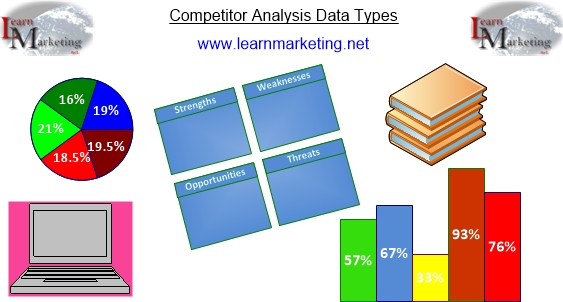Competitor Analysis
Competitor Data Types
Information from an array of sources can be collected on your competitors. Examples of data sources include:
- Competitor's websites.
- Annual reports produced by competitors.
- Observing competitor activity.
- News about competitors on the TV or in newspapers and magazines.
- Asking people using competitor products and services for their views about the competitor
- Mystery shopper and covert operations such as pretending to be a customer at your competitor's store, or phoning their telephone sales line.
 The diagram above shows examples of competitor analysis data sources and data types
The diagram above shows examples of competitor analysis data sources and data types
Competitor Data Sources
In 1997 Davidson suggested that data sources for competitior analysis information can be divided into three groups.
- Recorded data
This is data on competitors that has been published. This
data could be produced by the organisation itself (internal) e.g. annual reports or by an outside body (external) e.g. newspaper articles or magazine reviews of competitor products.
- Observable data
This is data collected through observing competitor activities. This could include analysing competitor marketing mix strategy, product launches and service offerings.
- Opportunistic data.
This type of data is collected through talking to bodies that have/have had contact with competitors such as their suppliers, their customers, and their former and/or current employees. Some firms take this a step further and employ employees who have worked for competitors.
Conclusion
Competitor analysis is crucial if the firm wants to stay ahead of the competition. Effective competitor analysis can give firms new ideas and help formulate strategies for growth by revealing how "others" carry out marketing. It can also allow firms to exploit the strengths and weaknesses of competitor firms.
Firms have lots of jobs to carry out so it can be easy to neglect competitors but you can not "beat the competition" if you do not know what they are doing. Do not make the mistake of neglecting competitor analysis; competitors are part of your marketing environment.
Previous




